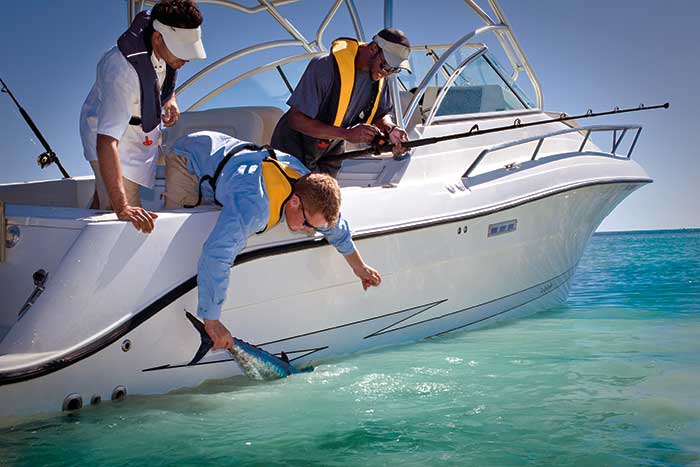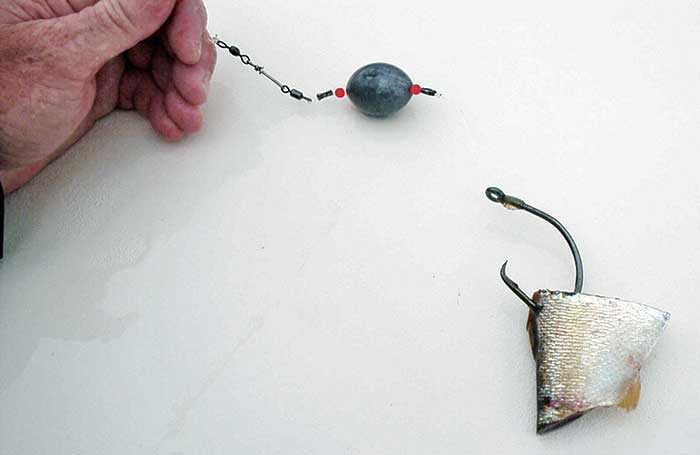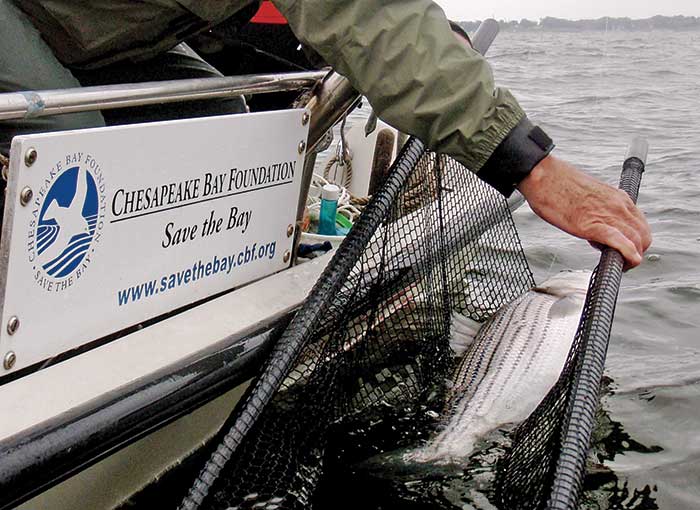Advertisement
Whether you're a dedicated catch-and-release angler or a meat fishermen throwing back an undersized fish, how you handle the fish is a matter of life or death.

An exhausted fish can be revived by pulling it through the water with its mouth open, to get water pumping across its gills. (Photo: David Lavine)
Though I haven't laid eyes on it for more than 30 years, I will never forget the fish that didn't get away. My father and I were trolling just north of the Chesapeake Bay Bridge in Maryland during the striped bass moratorium, hoping to catch our first bluefish of the year, when a rod towing a #21 Tony Acetta spoon doubled over. I wrestled it free of the holder and did little more than hold on tight as the fish peeled line off the reel. Then came the long pump-crank-pump fight, the hand-off of the rod to Dad, his pump-crank-pump, and then the hand-off back to me. I have no idea how long that fight lasted, only that the adrenaline rush from the initial strike never abated. And when the fish finally came into view we were shocked to see not the long, skinny form of a "racer" bluefish, but instead a fat cow striped bass in the oh-my-gawd-it's-huge size range.
We didn't even bring the fish aboard. Instead I lipped it with both hands, while my father reached down and slid the hook out of its jaw. Pausing no more than a second to take a mental snapshot I let it go — and watched the fish turn belly-up. Its white underside, bloated to the size of a soccer ball with roe, bobbed on the surface while our excitement turned into sickness.
As the fish drifted away an argument ensued. I wanted to take it home and eat it, so that at the very least it wouldn't go to waste. My father wouldn't so much as consider violating the law, even with an arguably moral reason. Then one of us remembered hearing about how you can revive a fish by holding it in the water with its mouth open, as you idle the boat forward, to pump water through its gills and give it a blast of oxygen. We agreed to give it a try and turned the boat around to retrieve the fish, but by then it was gone.
I like to think that the fish regained its strength, kicked its tail, dove beneath the surface of the bay and eventually made its way up to the Susquehanna spawning grounds. But truth be told, it may have just drifted out of sight, its white belly hidden among the white caps. Whatever happened to that fish, I know one thing for sure: I'll never forget the sight of that fat underside, wrong-side up.
Like many anglers, I like to keep and eat fish. But enough for a family dinner is plenty, and nothing breaks my heart more than releasing a fish that will likely die. I know this is true for most anglers, not just the dedicated catch-and-release crowd. So how do we make sure that the fish we throw back survive? Effective catch-and-release fishing can be broken down into four main criteria: fishing techniques, gear, handling, and releasing.
Fishing Techniques
We know from scientific studies that the largest variation in fish mortality is hooking location. When a fish is hooked deep in the gullet, its chances of living through a catch-and-release experience plummet. Mortality can jump from between one and five percent for jaw-hooked fish, to as much as 35 percent for fish that are hooked deeply. We also know that some fishing techniques, especially those utilizing natural bait, commonly lead to more deep-hooked fish as compared to techniques employed when fishing with lures. So as a general rule of thumb, for dedicated catch-and-release anglers, lures are a better choice.
Those anglers who do opt to fish with bait should be conscious that the longer they allow a fish to eat the bait also has a drastic effect on where their hook ends up. Setting the hook quickly is a must whenever you're catching lots of undersized fish or plan on releasing the catch.
How you play a fish also has an impact on its health upon release. Long, drawn-out fights are likely to tire the fish to the point of exhaustion. And remember, as far as the fish is concerned it's fighting for its life — it will literally fight itself to death, if you let it. At times, obviously, this can't be avoided. But unnecessarily extending the fight is never a good idea.

Fish in good condition should be gently released nose-down into the water. (Photo: Jim Gallop)
Even the weather has an effect on the fish's survival rates. As a rule of thumb, released fish do better in cooler waters. Since fish are cold-blooded, their metabolism is slower, and cooler water holds higher levels of dissolved oxygen. Just what is "cool" is relative to geography and species, but even fish that thrive in warmer waters will have a better chance of survival when released into water that's cool relative to their habitat.
Gear
The gear you use also has a huge impact on what level of damage you do to a fish, starting again with hooks. Obviously, barbless hooks are the best for catch-and-release fishing. At the other end of the spectrum lie treble hooks, which often hook the fish in multiple places at the same time and sometimes even pin a fish's mouth closed around the hook by setting in the lower and upper jaws at the same time. Removing fish hooked in this way regularly requires mangling their jaws, so catch-and-release anglers using lures with trebles should swap them out for single hooks.

Circle hooks usually catch the fish right in the corner of the jaw and are the best option for catch-and-release anglers using bait. (Photo: Lenny Rudow)
Bait anglers can do the fish a favor by using circle hooks, which usually snag the fish in the corner of the jaw and rarely lead to gut-hooked fish. We have to note, however, that this is only true for non-offset circle hooks (those that do not have a bend to one side or the other in the shank or curve), yet most circle hooks you'll see on the tackle shop shelves do have an offset. Shop carefully.
Almost as important as the hooks you choose are the tools you use to remove them. No boat should leave the dock without a dehooker, which allows you to release fish without having to handle them (more on this later). A pair of long-nose pliers, for gently removing deep-set hooks, is also important to keep on hand.
Another item high on the list is your net. Most nylon landing nets are quite damaging to fish, as the knots scrape against the fish and tend to remove its protective coating of slime. That slime is essentially a fish's immune system, containing antibodies and enzymes that help protect it from infection. The solution is to use a net that's specifically designed to go easy on the fish and has a rubberized or flexible plastic coating. The ultimate in fish-saving nets is the "cradle" net, which is more or less like a stretcher. This allows an angler to control the fish and remove the hook at boat-side without completely removing it from the water.
Finally, consider rods, reels, and fishing line. Remember how those protracted fights can cause the fish to tire itself beyond the point of recovery? Choosing tackle that's sufficient for quickly capturing the predominant size fish you're after will help you get those fish up to the boat and back off the line before they exhaust themselves.

A "cradle" style net can be very helpful when trying to handle a fish boatside, without causing it harm. (Photo: Shawn Kimbro)
Handling
The very best way to handle a fish you'll be releasing is to never remove it from the water. Many fish, like most bass species, can be safely controlled by "lipping" (placing your thumb inside the fish's mouth and clamping down on its lower jaw). You can use a "lip gripper" like a Boga Grip on bigger and toothier species.
It's understandable that sometimes people want to momentarily lift the fish up for a photo. Very large fish should not, however, be hoisted up vertically. This can cause damage to the fish's internal connective tissues, which are designed for a horizontal orientation and are normally supported to a degree by the water. Instead, when taking that photo, an angler should place an open hand under the fish's belly to give it some support — but never squeeze the belly area — and hold the fish in a more or less horizontal orientation. Prior to touching the fish in any way, shape, or form, you should always wet your hands. This is for the same reason you'll be getting one of those rubber-coated nets: dry hands tend to remove the fish's slime. Even worse is using a dry towel to grab and control a fish prior to release. The towel will virtually eliminate the slime everywhere it touches, almost guaranteeing future harm to the fish.
Another fish-handling no-no is sliding a finger or fingers under the gillplate. Those gills are red because they're full of blood. They are the equivalent of the fish's lungs, and any physical contact with them is bad for the fish.
Releasing
Have you ever seen an angler toss a fish up into the air, then heard it smack down onto the water's surface? Obviously, this isn't the best way to release a fish. Fish in good condition should be released gently, nose-down, into the water. Not only does this minimize any impact with the water, it also gives the fish a blast of oxygen-rich water. And remember, you can "feed" a fish oxygen and help it recover by holding it with its mouth open underwater, while the boat moves forward at a slow speed. If the boat's at anchor or adrift, you may also be able to turn the fish in figure eights next to the boat to get water pumping through its gills.
How will you know when the fish has sufficiently recovered and you can let go? When it starts biting down and/or kicking its tail, the fish is ready to swim free. Do your best to revive exhausted fish in this manner and, hopefully, you'll never have to look at a fat female fish bobbing at the surface, with its roe-filled belly floating wrong side up.
